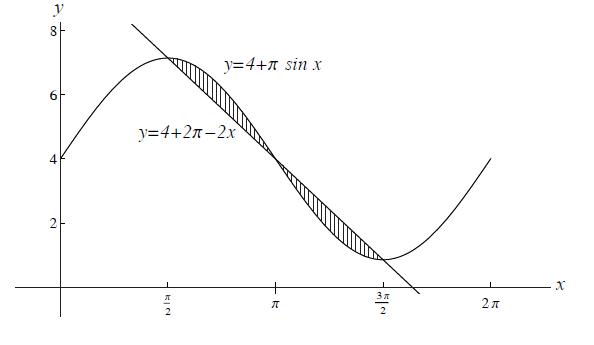Science:Math Exam Resources/Courses/MATH101/April 2013/Question 04 (a)
{{#incat:MER QGQ flag|{{#incat:MER QGH flag|{{#incat:MER QGS flag|}}}}}}
• Q1 (a) • Q1 (b) • Q1 (c) • Q2 (a) • Q2 (b) • Q2 (c) • Q3 (a) • Q3 (b) • Q3 (c) • Q4 (a) • Q4 (b) • Q5 (a) • Q5 (b) • Q6 (a) • Q6 (b) • Q7 (a) • Q7 (b) • Q8 • Q9 (a) • Q9 (b) • Q10 (a) • Q10 (b) • Q11 • Q12 (a) • Q12 (b) • Q12 (c) •
Question 04 (a) |
|---|
|
Full-Solution Problems. In questions 4–12, justify your answers and show all your work. If a box is provided, write your final answer there. Unless otherwise indicated, simplification of numerical answers is required in these questions. The graph below shows the region between and Find the area of this region. |
|
Make sure you understand the problem fully: What is the question asking you to do? Are there specific conditions or constraints that you should take note of? How will you know if your answer is correct from your work only? Can you rephrase the question in your own words in a way that makes sense to you? |
|
If you are stuck, check the hint below. Consider it for a while. Does it give you a new idea on how to approach the problem? If so, try it! |
Hint |
|---|
|
Make sure you are finding the area - so take care which function is on top! |
|
Checking a solution serves two purposes: helping you if, after having used the hint, you still are stuck on the problem; or if you have solved the problem and would like to check your work.
|
Solution |
|---|
|
To get our bounds of integration, we need to know where the intersection points are. Also, from the graph, the top function changes, so we need to find out exactly where this occurs, which is another point of intersection. The intersections can be found by solving This isn't easy to solve, but the graph shows three intersection points which can be estimated then checked. It looks like the three intersection points are . At , so this is a solution. At , so this is a solution. At , so this is a solution. Then, the intersection points are indeed . Notice the top function on is , whereas the top function on is . We have |
{{#incat:MER CT flag||
}}











![{\displaystyle \displaystyle [\pi /2,\pi ]}](https://wiki.ubc.ca/api/rest_v1/media/math/render/svg/c0059d7b39cb76c688b6dbb4f326b5ae104ab58e)

![{\displaystyle \displaystyle [\pi ,3\pi /2]}](https://wiki.ubc.ca/api/rest_v1/media/math/render/svg/0fdf61e93fb2350266f126b05ab26baa10f55597)

![{\displaystyle \displaystyle {\begin{aligned}A&=\int _{\pi /2}^{\pi }\left[(4+\pi \sin x)-(4+2\pi -2x)\right]\ dx\\&\qquad +\int _{\pi }^{3\pi /2}\left[(4+2\pi -2x)-(4+\pi \sin x)\right]\ dx\\&=(-\pi \cos x-2\pi x+x^{2}){\big |}_{\pi /2}^{\pi }+(\pi \cos x+2\pi x-x^{2}){\big |}_{\pi }^{3\pi /2}\\&=2(\pi -\pi ^{2}/4)\end{aligned}}}](https://wiki.ubc.ca/api/rest_v1/media/math/render/svg/058dce4d3a3fc2def30d4d09ccf83e2fb7795e9b)
